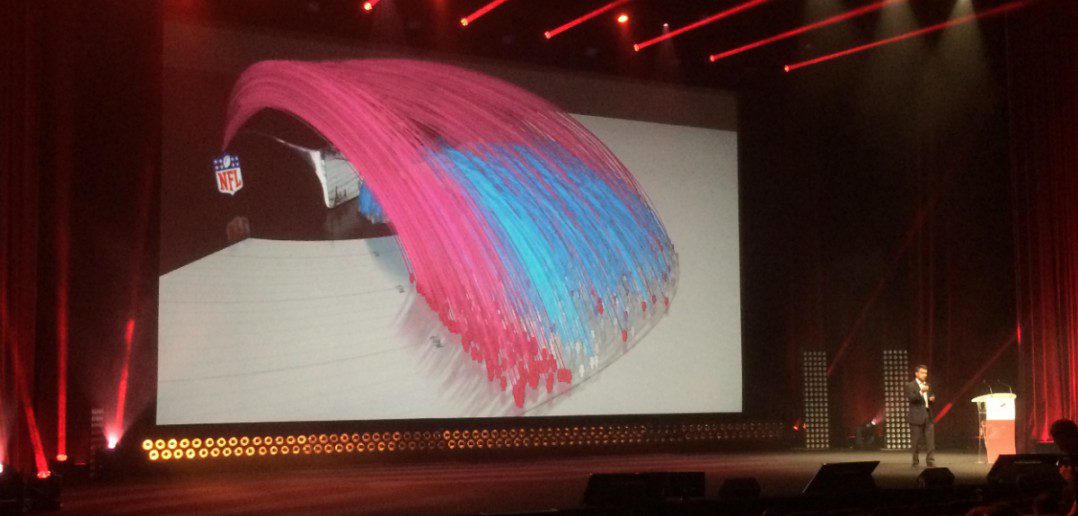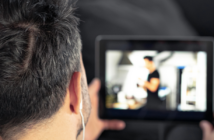Twitter’s role in the TV ecosystem is already well established, and has accelerated over the last year as hashtags and Twitter call-outs became increasingly common on live and pre-recorded shows alike.
Today, Twitter’s chief media scientist Deb Roy came to MIPTV to deliver a Media Mastermind keynote speech on his company’s role as a “force multiplier” for TV viewing, delivering what Roy has described as “the social soundtrack for TV”. His aim: to explain what this means for networks, producers and advertisers.
“A lot has happened in the last year for Twitter,” he noted, by way of an opening understatement: an IPO for starters. But he quickly moved on to “the biggest, most pervasive medium ever invented – television – is being intertwined with a global social medium, Twitter.”
But he also argued that “Twitter makes television better: it is in fact a force multiplier that can enhance the impact and possibilities of television“, suggesting that taking attention away from the TV screen to a second screen (e.g. a tablet or smartphone) doesn’t automatically mean that first screen is diminished.
One of his central questions: what is Twitter? He suggested three properties that set it apart: “It’s live, it’s public and it’s conversational. We use it in the moment to talk to everyone who cares to listen. And we use it to converse: to exchange words… A synchronised social soundtrack for whatever is happening in the moment, as a shared experience.”
Roy noted that soundtracks were originally designed to enhance the film experience: rather than being a threat, it “opened up the creative canvas… it’s hard to imagine today what E.T. would have been like without the soundtrack. Jaws, without the soundtrack was a silly robotic fish splashing around in the water!”
Roy showed some startling-looking data visualisations of how tweets spread over the course of a few hours, using the UK’s X Factor as an example. The ratio of the number of people watching to tweeting publicly is a way to start measuring “engagement properties” of any show, he suggested.
One X Factor show generated 21.8m impressions from 1.2m unique users in the UK – most of which were generated while the show was still airing. “Not only are people tweeting real-time in the moment, but on the receiving end, there is a way people use Twitter – to poll continuously… If you’re going to see a tweet, it’s usually in the few minutes after it’s produced.”
Roy also talked about the 2014 Oscars’ social impact. “5m people sent 19m tweets that were received by 37m unique people – these are tweets related to the 2014 Oscars – and if you count up over a 48-hour window, the number of tweet impressions delivered in that extended window exceeded 3bn,” he said. “The scale here is obviously significant.”
He moved on to whether Twitter drives people to tune in to TV shows – can it bump up the ratings? Roy showed a graph of tweets per minute about a Japanese news programme, when the Twitter volume suddenly spiked when the news anchor mentioned that a story was coming up about a prominent actress, with the editorial team also tweeting this message. “If we look at what happened in the next few minutes, the tune-in on TV almost doubled,” said Roy.
Is this just a one-off? He cited stats from Nielsen in the US, with a study that found “the volume of tweets caused statistically significant changes in live TV ratings among 29% of the episodes”. Roy admitted that this means it’s “not systematic… but there is growing evidence that the Twitter conversation can certainly change the level of tune-in.”
Roy talked ads, suggesting that ads placed around “highly social” TV shows drove higher return-in-investment for the advertisers, based on more research from Nielsen. “The same piece of advertising when you look at how much product it drives in sales, there’s a 7% increase,” he said, referring to ads around shows with lots of Twitter activity. “A couple of hundred million dollars spent on TV advertising, by paying attention to where the social signal is from, it actually has bottom-line effects.”
Why? One reason is that people are watching more of the ads – they’re less likely to tune away when the ad break starts. “No matter how you slice it, the complementary activity of having Twitter active with television seems to be leading to positive outcomes from the advertiser point of view,” he said.
Roy talked about the desirability of having an “emerging standard” in measuring TV, using the social signals. Nielsen is working on this in the US, Italy and Australia, including a “Twitter TV Rating” chart in the US. Video Research is doing a similar ratings product in Japan, gFK in Germany, Austria and the Netherlands, and now Twitter is working with Kantar Media in the UK, Spain, Russia, the Nordics and parts of south east Asia and Africa.
“This is a complementary orthogonal new dimension of television that will be measured exclusively using the Twitter signal,” he said, before noting Twitter’s recent acquisition of SecondSync and Mesagraph, two European companies that have been working around Twitter and TV, before moving on to share an example of Twitter’s TV Amplify scheme. “A new capability that has been engineered essentially to augment and add to the organic social soundtrack,” as he described it. The case study was the NFL: audiences watching American Football matches while using Twitter.
Amplify helps the NFL send out tweets with up to 30 seconds of video of just-aired content from television, complete with a pre-roll advertisement. The idea: people who aren’t watching the live event on TV can see what just happened: and potentially then tune in. “To use Twitter to broadcast and potentially extend the reach beyond the set of people who were watching the programme,” as he put it.
Roy returned to the notion of Twitter as live, public and conversational, pointing out that there is a second mode: “Its function as a broadcast network that augments traditional broadcast. So is it a social network or a broadcaster? “What makes Twitter truly special is that it’s both,” he said.
Roy talked about the importance of a “visible crowd” to draw people’s attention to something happening. “You can think of Twitter as opening you up to worlds you would not otherwise have access to,” he said, talking about hashtags as “public windows” into topics (or TV shows). And he also talked about how tweets find their way into other media: politicians’ tweets show up in newspapers, TV viewers’ tweets are incorporated into the shows they’re watching.
Roy ended with a summary. “As we survey the landscape of broadcast television – all this premium high quality content – think of that as layer one, and layer two is the audience, people watching various programmes. Start with the traditional notion of a broadcast event – one piece of TV programming reaches a certain number of people. And we have the function of Twitter as this social network: what it’s doing is it’s connecting your audience to one another, creating this audience network,” said Roy.
In its wake is a much larger “earned audience” beyond the basic TV audience, which can then draw in more people to watch. Then layer on top of that the idea of Twitter as a broadcast medium – Amplify, or actors/presenters tweeting while a show is on – and those broadcast pieces of content can then “trigger new cascades of conversation”.
Roy finished off with a challenge, of sorts, to the creatives in the MIPTV audience: “I actually think the real puzzle in social TV and what’s happening with Twitter and television comes down to storytelling,” he said, suggesting that certain genres, shows, characters and plotlines “systematically activate massive conversations on Twitter. So the challenge and the opportunity is in the hands of storytellers in how to tap into this new creative storytelling, and evolve storytelling”.
How? Roy suggested that creatives should be prepared to “look to the data, and to really go and pioneer potentially whole new genres” of television. Exciting times.




